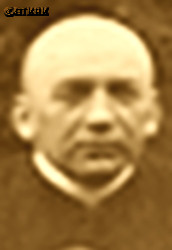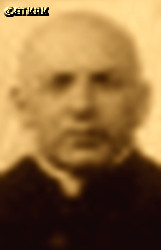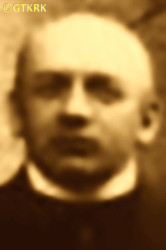Roman Catholic
St Sigismund parish
05-507 Słomczyn
85 Wiślana Str.
Konstancin deanery
Warsaw archdiocese, Poland
full list:
displayClick to display full list

searchClick to search full list by categories
wyświetlKliknij by wyświetlić pełną listę po polsku

szukajKliknij by przeszukać listę wg kategorii po polsku

Martyrology of the clergy — Poland
XX century (1914 – 1989)
personal data
surname
GRUDZIŃSKI
forename(s)
Emanuel
function
diocesan priest
creed
Latin (Roman Catholic) Church RCmore on
en.wikipedia.org
[access: 2014.09.21]
diocese / province
Culm (Chełmno) diocesemore on
pl.wikipedia.org
[access: 2012.11.23]
honorary titles
Ad Honores Spiritual Counselor
(c. 1937)
Gold „Cross of Merit”more on
en.wikipedia.org
[access: 2019.04.16]
(08.02.1930)
date and place
of death
17.10.1939

alt. dates and places
of death
VSH Resmintemporary custody
today: Radzim, Kamień Krajeński gm., Sępólno Krajeńskie pov., Kuyavia‐Pomerania voiv., Poland
more on
pl.wikipedia.org
[access: 2017.01.21]
VSH Karlshoftemporary custody
today: Karolewo, Więcbork gm., Sępólno Krajeńskie pov., Kuyavia‐Pomerania voiv., Poland
more on
pl.wikipedia.org
[access: 2020.07.31]
KL Stutthofconcentration camp
today: Sztutowo, Sztutowo gm., Nowy Dwór Gdański pov., Pomerania voiv., Poland
more on
en.wikipedia.org
[access: 2022.01.09]
details of death
During World War I, drafted into the German Imperial Army. Ministered as a chaplain–medical orderly.
After German and Russian invasion of Poland in 09.1939 and start of the World War II, after start of German occupation, arrested by the Germans on 14.10.1939 and kept for 3 days in Sępólno Krajeńskie prison.
From there transported out in unknown direction.
Murdered in unknown circumstances.
Possible places of death: one of the concentration and custodies VSH Resmin in Radzim, VSH Karlshof in Karolewo or KL Stutthof concentration camp.
alt. details of death
It is possible that from the detention center in Sępólno Krajeńskie was taken to the VSH Rezmin custody in Radzim — his vicar, Fr Stanislav Żurek, was arrested by the Germans 4 days after his arrest, and from Sępólno Krajeńskie he was taken to VSH Rezmin and murdered there.
The arrests and genocidal murders — on the estate belonging to the Polish Seyda family in the village of Radzim, whose owner was shot by the Germans, c. 6 km east of Kamień Krajeński and c. 11 km north of the county town of Sępólno Krajeńskie — were carried out, as part of the Germ. «Intelligenzaktion» (Eng. „Action Intelligence”), i.e. the extermination of the Polish intelligentsia and the leadership classes of Pomerania, by the genocidal unit of the Germ. Volksdeutscher Selbstschutz (Eng. Self‐Defense of Ethnic Germans), i.e. VS, whose members were Germ. Volksdeutsche (Eng. Ethnic Germans), i.e. representatives of the German minority in Poland from Sępólno Krajeńskie, Kamień Krajeński and the surrounding area. Organizationally, they were subordinate to Inspectorate IV VS Konitz with its seat in Chojnice, belonging to the Germ. Bezirk III Nord (Eng. Northern District) of VS. They were prob. supervised by members of the paramilitary, genocidal Germ. Die Schutzstaffel der NSDAP (Eng. NSDAP Protection Unit), i.e. «SS», subordinate to the ruling National Socialist German Workers' Party NSDAP. The commander of the VS in the Sępolno district was a member of the «SS», arrived from Germany on German tanks, a certain William Richardt, who publicly proclaimed that „it would be an honor for every Pole to fertilize German soil with his carcass”.
The border areas, where Radzim was located, were occupied by the Germ. Wehrmacht (Eng. Armed Forces) in the first days of the war, i.e. on c. 01.09.1939. The VSH Rezmin camp in Radzim was established early, in mid‐09.1939, even before the Germ. Wehrmacht transferred power to civilian hands. The commander, his deputy, and most of the crew came were citizens of the Polish state — traitorous Germ. Volksdeutsche.
At any one time, in VSH Rezmin c. 150‐600 people were held in the basements of the estate, with up to several hundred people crammed into each cellar.
Those arrested — on the basis of the one of the so‐called Germ. Sonderfahndungsliste (Eng. Special Wanted List), i.e. a proscription list of names of „enemies of the Reich”, prepared before the German aggression, or on some other proscription list, drawn up ad hoc, compiled based on denunciations from local Germ. Volksdeutsche — after registration and confiscation of personal belongings, were interrogated. In practice, the interrogation turned into the so‐called Germ. Volksgericht (Eng. People's Court), a kangaroo court whose members were — according to some sources — eight Germ. Volksdeutsche. The „judges” of the Germ. Volksgericht, the murderers dressed in judicial attire, knew only one verdict — the death sentence, which only confirmed the decision taken earlier and elsewhere, and which immediately became final.
Murders were committed in the manor cellars, in the park surrounding the manor, by Lake Zaremba, or outside the estate. A prisoner who survived the execution testified that in his case, c. 22 people were taken by car to Lake Zamarte, where a hole c. 2x3 m had previously been dug. The victims were led out of the car in groups of four. Some of the the VSH Rezmin prisoners were transported out and murdered elsewhere, i.a. in the forests not far form the Rudzki Most wilderness near Tuchola.
The number of victims is unknown. Formally, according to exhumation reports conducted in 05‐06.1947, the remains of 109 people, including 11 women and one child, were recovered from nine mass graves. However, sources indicate that the marshy ground of the park „prevented a thorough examination of the area”.
The number of prisoners in the VSH Rezmin camp is also unknown. It is estimated that a total of 2,500 people were held there, although according to some opinions, there could have been as many as 10,000. The camp, although formally liquidated on 20.11.1939, continued to operate until the first days of 12.1939.
Most of the German murderers were never punished, protected by the „justice system” of the Germ. kulturnation (Eng. cultural nation).
cause of death
mass murder
perpetrators
Germans
sites and events
VSH KarlshofClick to display the description, VSH ResminClick to display the description, KL StutthofClick to display the description, «Intelligenzaktion»Click to display the description, Reichsgau Danzig‐WestpreußenClick to display the description, Ribbentrop‐MolotovClick to display the description, Pius XI's encyclicalsClick to display the description
date and place
of birth
01.06.1886

Sylcznotoday: Parchowo gm., Bytów pov., Pomerania voiv., Poland
more on
en.wikipedia.org
[access: 2022.01.28]
alt. dates and places
of birth
01.06.1866
Sitna Góratoday: Kartuzy gm., Kartuzy pov., Pomerania voiv., Poland
more on
en.wikipedia.org
[access: 2022.01.28]
parents
GRUDZIŃSKI Francis
🞲 ?, ? — 🕆 ?, ?

GŁĄBIEWSKA Emily
🞲 ?, ? — 🕆 ?, ?
presbyter (holy orders)
ordination
02.04.1911

Pelplintoday: Pelplin gm., Tczew pov., Pomerania voiv., Poland
more on
en.wikipedia.org
[access: 2021.05.06]
St Barbara RC chapelmore on
pl.wikipedia.org
[access: 2021.12.19] (in Theological Seminary)
positions held
1919 – 1939
parish priest — Sępólno Krajeńskietoday: Sępólno Krajeńskie gm., Sępólno Krajeńskie pov., Pomerania voiv., Poland
more on
en.wikipedia.org
[access: 2021.09.02] ⋄ St Bartholomew the Apostle RC parish ⋄ Kamień Pomorskitoday: Kamień Krajeński, Kamień Krajeński gm., Sępólno Krajeńskie pov., Pomerania voiv., Poland
more on
en.wikipedia.org
[access: 2021.09.02] RC deanery — also: inspector of religious education in elementary schools in the deanery
vicar — Pelplintoday: Pelplin gm., Tczew pov., Pomerania voiv., Poland
more on
en.wikipedia.org
[access: 2021.05.06] ⋄ Corpus Christi RC parish ⋄ Gniewtoday: Gniew gm., Tczew pov., Pomerania voiv., Poland
more on
en.wikipedia.org
[access: 2021.07.29] RC deanery
c. 1914 – c. 1918
RC military chaplain — German Imperial Army
1911 – 1919
vicar — Chojnicetoday: Chojnice urban gm., Chojnice pov., Pomerania voiv., Poland
more on
en.wikipedia.org
[access: 2021.09.02] ⋄ Beheading of St John the Baptist RC parish ⋄ Człuchówtoday: Człuchów gm., Człuchów pov., Pomerania voiv., Poland
more on
en.wikipedia.org
[access: 2021.09.02] RC deanery
1907 – 1911
student — Pelplintoday: Pelplin gm., Tczew pov., Pomerania voiv., Poland
more on
en.wikipedia.org
[access: 2021.05.06] ⋄ philosophy and theology, Theological Seminary
pupil — Wejherowotoday: Wejherowo gm., Wejherowo pov., Pomerania voiv., Poland
more on
en.wikipedia.org
[access: 2021.09.02] ⋄ Germ. Königliche Gymnasium (Eng. Royal Gymnasium) — studies crowned in 1907 with the maturity diploma (i.e. matura)
1897 – 1899
pupil — Pelplintoday: Pelplin gm., Tczew pov., Pomerania voiv., Poland
more on
en.wikipedia.org
[access: 2021.05.06] ⋄ „Collegium Marianum” progymnasium
others related
in death
BARRAClick to display biography Roman Francis, MAZELLAClick to display biography John, ŻUREKClick to display biography Stanislav Louis
sites and events
descriptions
VSH Karlshof: German Germ. Volksdeutscher Selbstschutzhaft (Eng. Volksdeutscher Selbstschutz custody) VSH — established in Karolewo (today Sępólno Krajeńskie poviat) by the genocidal German paramilitary organization Volksdeutscher Selbstschutz — the decision to create Selbstschutz in the Polish lands occupied by German troops was made in Berlin on 08‐10.09.1939 at a conference headed by Reichsführer‐SS Heinrich Himmler (the formal order bears the date 20.09.1939), and the chaotically formed units were directly subordinated to the officers of the genocidal SS organization — as part of the «Intelligenzaktion» action — the extermination of the Polish intelligentsia and leadership classes in Pomerania — for Poles from the Krayna region. By 12.1939, when the camp was closed, the Germans murdered, in Karolewo and the surrounding forests, most of the Poles held in the camp — the number of victims is sometimes estimated from 4,000 to 10,000 people, although contemporary estimates range from 1,781 to 2,643. (more on: pl.wikipedia.orgClick to attempt to display webpage
[access: 2013.05.19], en.wikipedia.orgClick to attempt to display webpage
[access: 2013.07.06])
VSH Resmin: German Germ. Volksdeutscher Selbstschutzhaft (Eng. Volksdeutscher Selbstschutz custody) VSH — established for the inhabitants of Krajna land by the genocidal German paramilitary organization Volksdeutscher Selbstschutz — the decision to create Selbstschutz in the Polish lands occupied by German troops was made in Berlin on 08‐10.09.1939 at a conference headed by Reichsführer‐SS Heinrich Himmler (the formal order bears the date 20.09.1939), and the chaotically formed units were directly subordinated to the officers of the genocidal SS organization — on an estate in the village of Radzim, operating from 10.1939 till 12.1939. Germans held exclusively men in the camp; (some women and children who were accidently brought to the camp were murdered on the spot). Among others on c. 15.01.1939 Germans brought to it — and to a small Komierowo sub‐camp, c. 10 km away — all prisoners of a nearby — c. 10 km — VSH Drausnitz custody in Drożdzienica. As a part of «Intelligenzaktion» — aimed at extermination of Polish intelligentsia and ruling classes in Pomerania — Germans murdered in Radzim approx. 5,000 victims. They were murdered at the camp itself (mainly in the manor’s park) or executed outside, in a site of mass executions in Rudzki Most n. Tuchola among others. (more on: pl.wikipedia.orgClick to attempt to display webpage
[access: 2013.05.19])
KL Stutthof: In German Germ. Konzentrationslager (Eng. concentration camp) KL Stutthof (then in Eastern Prussian belonging to Germany, today: Sztutowo village) concentration camp, that Germans started to build on 02.09.1939, a day after German invasion of Poland and start of the World War II, Germans held c. 110,000‐127,000 prisoners from 28 countries, including 49,000 women and children. C. 65,000 victims were murdered and exterminated. In the period of 25.01‐27.04.1945 in the face of approaching Russian army Germans evacuated the camp. When on 09.05.1945 Russians soldiers entered the camp only 100 prisoners were still there. In an initial period (1939‐1940) Polish Catholic priests from Pomerania were held captive there before being transported to KL Dachau concentration camp. Some of them were murdered in KL Stutthof or vicinity (for instance in Stegna forest). Also later some Catholic priests were held in KL Stutthof. (more on: stutthof.orgClick to attempt to display webpage
[access: 2018.11.18], en.wikipedia.orgClick to attempt to display webpage
[access: 2013.07.06])
«Intelligenzaktion»: German: «Intelligenzaktion» (English: „Intelligence Action”) — a German program of extermination of the Polish elite, mainly the intelligentsia and leadership layers, carried out from the beginning of the occupation in w 09.1939 to 04.1940, mainly in territories directly annexed to Germany, but also in the so‐called Germ. Generalgouvernement (Eng. General Governorate), where it was called «AB‐aktion». In the first phase, immediately after the beginning of the German occupation, during military operations carried out by the Germ. Wehrmacht (Eng. Armed Forces) and the genocidal units of the Germ. Einsatzgruppen (Eng. Operational Groups) of the Germ. Sicherheitspolizei (Eng. Security Police), i.e. SiPo, and Germ. Sicherheitsdienst des Reichsführers SS (Eng. Security Service of the Reichsführer SS), i.e. SD, organized by the Germ. Reichssicherheitshauptamt (Eng. Reich Main Security Office), i.e. RSHA, which followed the troops, carried out under the Germ. Unternehmen „Tannenberg” (Eng. Operation „Tannenberg”) — based on the so‐called Germ. Sonderfahndungsliste (Eng. Special Wanted Lists), i.e. proscription lists of Poles considered particularly dangerous to the Third Reich, prepared by the Zentralstelle II/P (Polen) unit of the German RSHA. Later, implemented by the German civilian occupation authorities and the genocidal unit of the Germ. Volksdeutscher Selbstschutz (Eng. Ethnic Germans Self‐Defense), whose members were Germ. Volksdeutsche (Eng. Ethnic Germans), i.e. representatives of the German minority in Poland. According to various sources, these lists, at the beginning of 09.1939, could have contained the details of 61,000—88,000 „dangerous” Poles — although these figures cannot be confirmed. In total, during this genocide, c. 50,000 teachers, Catholic priests, representatives of the landed gentry, freelancers, social and political activists, and retired military personnel were systematically and methodically murdered. Another 50,000 were sent to concentration camps, where only a negligible percentage survived. (more on: en.wikipedia.orgClick to attempt to display webpage
[access: 2014.10.04])
Reichsgau Danzig‐Westpreußen: After the Polish defeat in the 09.1939 campaign, which was the result of the Ribbentrop‐Molotov Pact and constituted the first stage of World War II, and the beginning of German occupation in part of Poland (in the other, eastern part of Poland, the Russian occupation began), the Germans divided the occupied Polish territory into five main regions (and a few smaller). The largest one was transformed into Germ. Generalgouvernement (Eng. General Governorate), intended exclusively for Poles and Jews and constituting part of the so‐called Germ. Großdeutschland (Eng. Greater Germany). Two were added to existing German provinces. From two other separate new provinces were created. Vistula Pomerania region was one of them, incorporated into Germany on 08.10.1939, by decree of the German leader Adolf Hitler (formally came into force on 26.10.1939), and on 02.11.1939 transformed into the Germ. Reichsgau Danzig‐Westpreußen (Eng. Reich District of Gdańsk‐West Prussia) province, in which the law of the German state was to apply. The main axis of the policy of the new province, the territory of which the Germans recognized as the Germ. „Ursprünglich Deutsche” (Eng. „natively German”), despite the fact that 85% of its inhabitants were Poles, was Germ. „Entpolonisierung” (Eng. „Depolonisation”), i.e. forced Germanization. C. 60,000 Poles were murdered in 1939‐1940, as part of the Germ. „Intelligenzaktion”, i.e. extermination of Polish intelligentsia and ruling classes, in c. 432 places of mass executions — including c. 220 Polish Catholic priests. The same number were sent to German concentration camps, from where few returned (over 300 priests were arrested, of whom c. 130 died in concentration camps). C. 124,000‐170,000 were displaced, including c. 90,000 to the Germ. Generalgouvernement. Poles were forced en masse to sign the German nationality list, the Germ. Deutsche Volksliste DVL. Polish children could only learn in German. It was forbidden to use the Polish language during Catholic Holy Masses and during confession. Polish landed estates were confiscated..To further reduce the number of the Polish population, Poles were sent to forced labor deep inside Germany. The remaining Poles were treated as low‐skilled labor, isolated from the Germans and strictly controlled — legally, three or three of them could only meet together, even in their own apartments. Many were conscripted into the German Wehrmacht army. After the end of hostilities of World War II, the overseer of this province, the Germ. Reichsstatthalter (Eng. Reich Governor) and the Germ. Gauleiter (Eng. district head) of the German National Socialist Party, Albert Maria Forster, was executed. (more on: en.wikipedia.orgClick to attempt to display webpage
[access: 2024.06.24])
Ribbentrop‐Molotov: Genocidal Russian‐German alliance pact between Russian leader Joseph Stalin and German leader Adolf Hitler signed on 23.08.1939 in Moscow by respective foreign ministers, Mr. Vyacheslav Molotov for Russia and Joachim von Ribbentrop for Germany. The pact sanctioned and was the direct cause of joint Russian and German invasion of Poland and the outbreak of the World War II in 09.1939. In a political sense, the pact was an attempt to restore the status quo ante before 1914, with one exception, namely the „commercial” exchange of the so‐called „Kingdom of Poland”, which in 1914 was part of the Russian Empire, fore Eastern Galicia (today's western Ukraine), in 1914 belonging to the Austro‐Hungarian Empire. Galicia, including Lviv, was to be taken over by the Russians, the „Kingdom of Poland” — under the name of the General Governorate — Germany. The resultant „war was one of the greatest calamities and dramas of humanity in history, for two atheistic and anti‐Christian ideologies — national and international socialism — rejected God and His fifth Decalogue commandment: Thou shall not kill!” (Abp Stanislav Gądecki, 01.09.2019). The decisions taken — backed up by the betrayal of the formal allies of Poland, France and Germany, which on 12.09.1939, at a joint conference in Abbeville, decided not to provide aid to attacked Poland and not to take military action against Germany (a clear breach of treaty obligations with Poland) — were on 28.09.1939 slightly altered and made more precise when a treaty on „German‐Russian boundaries and friendship” was agreed by the same murderous signatories. One of its findings was establishment of spheres of influence in Central and Eastern Europe and in consequence IV partition of Poland. In one of its secret annexes agreed, that: „the Signatories will not tolerate on its respective territories any Polish propaganda that affects the territory of the other Side. On their respective territories they will suppress all such propaganda and inform each other of the measures taken to accomplish it”. The agreements resulted in a series of meeting between two genocidal organization representing both sides — German Gestapo and Russian NKVD when coordination of efforts to exterminate Polish intelligentsia and Polish leading classes (in Germany called «Intelligenzaktion», in Russia took the form of Katyń massacres) where discussed. Resulted in deaths of hundreds of thousands of Polish intelligentsia, including thousands of priests presented here, and tens of millions of ordinary people,. The results of this Russian‐German pact lasted till 1989 and are still in evidence even today. (more on: en.wikipedia.orgClick to attempt to display webpage
[access: 2015.09.30])
Pius XI's encyclicals: Facing the creation of two totalitarian systems in Europe, which seemed to compete with each other, though there were more similarities than contradictions between them, Pope Pius XI issued in 03.1937 (within 5 days) two encyclicals. In the „Mit brennender Sorge” (Eng. „With Burning Concern”) published on 14.03.1938, condemned the national socialism prevailing in Germany. The Pope wrote: „Whoever, following the old Germanic‐pre‐Christian beliefs, puts various impersonal fate in the place of a personal God, denies the wisdom of God and Providence […], whoever exalts earthly values: race or nation, or state, or state system, representatives of state power or other fundamental values of human society, […] and makes them the highest standard of all values, including religious ones, and idolizes them, this one […] is far from true faith in God and from a worldview corresponding to such faith”. On 19.03.1937, published „Divini Redemptoris” (Eng. „Divine Redeemer”), in which criticized Russian communism, dialectical materialism and the class struggle theory. The Pope wrote: „Communism deprives man of freedom, and therefore the spiritual basis of all life norms. It deprives the human person of all his dignity and any moral support with which he could resist the onslaught of blind passions […] This is the new gospel that Bolshevik and godless communism preaches as a message of salvation and redemption of humanity”… Pius XI demanded that the established human law be subjected to the natural law of God , recommended the implementation of the ideal of a Christian state and society, and called on Catholics to resist. Two years later, National Socialist Germany and Communist Russia came together and started World War II. (more on: www.vatican.vaClick to attempt to display webpage
[access: 2023.05.28], www.vatican.vaClick to attempt to display webpage
[access: 2023.05.28])
sources
personal:
www.wtg-gniazdo.orgClick to attempt to display webpage
[access: 2012.11.23], www.wiadomosci.zas.plClick to attempt to display webpage
[access: 2013.07.06], www.parafia-sepolno.plClick to attempt to display webpage
[access: 2021.12.19], m.facebook.comClick to attempt to display webpage
[access: 2023.02.20]
bibliographical:
„Biographical dictionary of priests of the Chełmno diocese ordained in the years 1821‐1920”, Henry Mross, Pelplin, 1995
original images:
krajna.com.plClick to attempt to display webpage
[access: 2018.11.18], sepolno.krajenskie.archiwa.orgClick to attempt to display webpage
[access: 2018.11.18], sepolno.krajenskie.archiwa.orgClick to attempt to display webpage
[access: 2018.11.18], www.facebook.comClick to attempt to display webpage
[access: 2023.12.09]
LETTER to CUSTODIAN/ADMINISTRATOR
If you have an Email client on your communicator/computer — such as Mozilla Thunderbird, Windows Mail or Microsoft Outlook, described at WikipediaPatrz:
en.wikipedia.org, among others — try the link below, please:
LETTER to CUSTODIAN/ADMINISTRATORClick and try to call your own Email client
If however you do not run such a client or the above link is not active please send an email to the Custodian/Administrator using your account — in your customary email/correspondence engine — at the following address:

giving the following as the subject:
MARTYROLOGY: GRUDZIŃSKI Emanuel
To return to the biography press below:
 Click to return to biography
Click to return to biography












